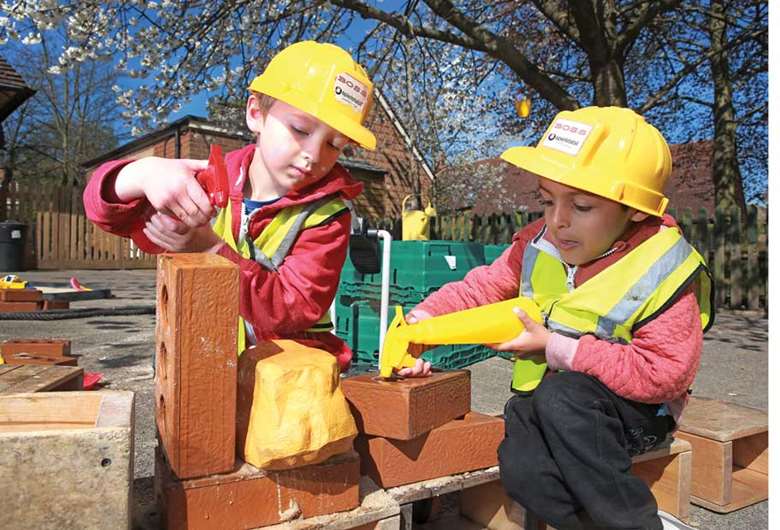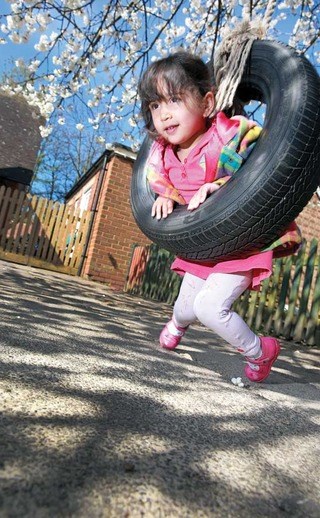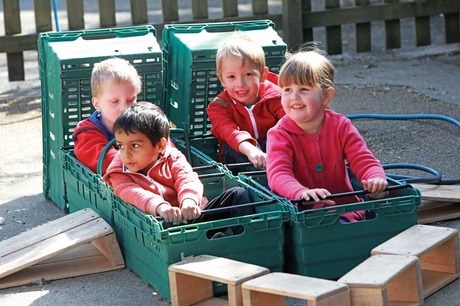Nursery Equipment: Outdoors - Open plan
Ruth Thomson
Monday, May 19, 2014
The importance of outdoor play to development is well documented. Julie Mountain explains how to get right both attitude and resources.

The best classroom and the richest cupboard is roofed only by the sky.' Margaret McMillan's familiar quote is often used by early years practitioners, and it's an apposite reminder, if refurbishing or expanding, to go back to basics when planning for outdoor play.
While adults' - and policy - priorities may seem to change with the seasons, children still like to do what they've always done outdoors: construct, move and be noisy, investigate and get messy. The trick, as always, is to combine their natural and urgent need to play outdoors with your intended learning outcomes - and the best way to do that is to start with what children want to do outdoors.
KEY TRENDS
While children's basic outdoor play urges don't change significantly, the context for them does, and we have largely moved away from a 'take indoors outside' approach. The work of outdoor play advocates such as Helen Bilton, Jan White and Julian Grenier means practitioners are much more aware of what outdoors can do for children that indoors can't - for example, satisfy their impulse to move, investigate and construct. There are clear trends in early years, and these are being seen in early primary too.
- Much has been made in recent years of children's increasingly sedentary lives and the disappearing opportunities for play in a natural environment and with natural materials. Settings are redressing this imbalance by introducing planted areas - flowers, fruit trees, herbs and aromatic plants, vegetable plots and grassy spaces. Forest School has become commonplace, but no less magical for that, and in Scotland, school grounds charity Grounds for Learning has been pioneering the use of large-scale natural materials for play - hay bales, bunkers of sand, logs and water courses.
- The relationship between writing and strong, flexible and resilient hands, arms and upper body is now widely understood. Settings are establishing more opportunities for children to manipulate loose-parts materials, such as sand, gravel, chalk, corks and mud. Mark-making is encouraged and settings are recognising that this takes many forms, not all of which are 'neat and tidy'.
- Zoning a space has always been a logical way of planning an outdoor play area, but the focus is moving away from types of play activity (for example, active play/quiet area/gardening) to types of activity or schemas. A subtle difference, perhaps, but now, when examining ways of improving outdoor spaces, we talk about how we can plan for the development of specific motor skills, or ways to encourage children to listen or concentrate for prolonged periods.
- The design of early childhood spaces has become much more adventurous, although there is still far too much 'off the shelf' equipment being installed with little attention paid to the needs of the children it's being purchased for. Huge, walk-in sandpits, multi-textured bike tracks, wooded hidey-holes and messy mud kitchens are now popular and often dramatic interventions. My series on Professor Susan Herrington's 7Cs approach to the design of early childhood landscapes is currently running in Nursery World (and at www.nurseryworld.co.uk), addressing the landscape factors that influence high-quality outdoor play.
- While many settings embrace risk and challenge outdoors, there is still some way to go before all children are able to do so. This is largely an issue of 'attitude' - risk aversion in adults (practitioners and parents) is still prevalent, despite great work by the Health and Safety Executive, the UK's play councils and individuals such as Tim Gill. This fearfulness manifests itself in carpets of (expensive) rubber where it's not needed, shrubs cut back to minimise hidden spaces, and play frames 'out of order' because they are slippery when wet. Life is slippery when wet. Where better to learn how to manage this reality than your setting?
WHAT ARE CHILDREN ACTUALLY DOING?

It will come as no surprise to hear that, despite regular tweaks to the early years curriculum, pressing environmental concerns and health and safety scares, what children like to do outdoors has changed little. I encourage settings to undertake a twin-track audit of their play spaces. One audit examines the physical features and resources in the spaces, and the other looks specifically at what children are doing, with whom, where, for how long and with what resources.
This 'using your space' audit also invites practitioners to listen to children's conversations and record their play in whatever medium feels most comfortable for the children. We make great use of Alison Clark and Peter Moss's 'mosaic approach' to draw out children's thoughts and ideas and map our findings onto annotated plans of outdoor spaces.
Written records, photographs, learning journeys and film footage show that children, given a free choice and rich resources, will:
Move: indoors, children know, is the place to sit, be still, take care and keep the noise down. Outdoors, big voices and big movements can be encouraged, even in small spaces. The link between movement and neurological development is well documented, but young children don't need to read papers to know this: the imperative to move is irrepressible.
Investigate: the desire to know by doing is almost as strong as the desire to move. Margaret McMillan's 'cupboard' outdoors is fully stocked with mysteries, and the very simplest of resources will enable children to find out more for themselves - a stick to poke in the soil, a piece of string to join two objects together, a magnifying pooter to examine minibeasts.
Construct: using any materials they can source, children will build dens, towers, tunnels, houses, vehicles ... the list is long! The imaginative element of construction play is at least as important as the physical development skills that children are displaying. In addition, the quality of conversation while children collaborate to move large hollow blocks, awkward long sticks or peg a sheet to a play frame is notable for its breadth and vitality.
Knowing what children prefer to do outdoors helps us identify the resources needed to fulfil these requirements.
SOME OF THE CHALLENGES
The implementation of early years curricula across the UK stirred up enormous controversy during the 2000s, but for those of us promoting the importance of outdoor play in young children's lives, the language used and concepts contained within them offered a leap forwards. For the first time, the need for outdoor play in the early years became explicit.
The expectation of outdoor play at every setting raised numerous challenges, and many of them still exist: availability of immediately accessible outside space; practitioner confidence; budget constraints; parents' attitudes; adults' tendency to be risk averse. Much of my work in settings is focused on helping them overcome these barriers; the most richly resourced outdoor space will never reach its potential if the adults occupying it are fearful. However, clever resourcing can alleviate some of the challenges.
Making 'free flow' work
The ideal of freely flowing, independently chosen indoor-outdoor play is a lofty one. In practice, it is very difficult to achieve, and most settings I know aim to reach compromises that meet the needs of children. The demands of hygiene routines, refreshments, staffing and the curriculum itself (particularly for three- and four-year-olds) make it almost impossible to truly offer a free-flow regime. Instead, consider:
- free-flow curtains - these do allow children to see out (and in) and make independent decisions about where to be. Most good educational suppliers now offer these curtains in their catalogues
- ratios - be flexible and communicate with your colleagues. Some settings allocate at least one adult to 'outdoors' at all times and emphasise the importance of remaining aware of approximate numbers. In England, the EYFS now makes it clear that ratios are to be maintained across the continuous learning environment; you can use your judgement, and dynamic risk assessment, to decide how many adults should be outdoors
- placing outdoor clothing on accessible racks immediately beside the door (under a transition canopy is ideal). Choose waterproof dungarees - more flexible than all-in-ones - and provide plenty of wellies, as children like to wear these whatever the weather.
Storage
Dealing with storage can be the most frustrating aspect of an early years practitioner's day. Lack of storage; poor-quality storage; in the wrong place; the wrong size or shape; children able/unable to access it; can't be locked ... sound familiar?
When planning a new space or refurbishing an existing one, clear routes around the space and storage within it are two cornerstones of effective management. In general, no one type of storage is appropriate across the whole of a setting's outdoor space. Complement low-level, front-opening storage units (great for children to access independently) with generously proportioned sheds with high-level shelves for items you'd rather manage access to, plus room for bikes and trikes. Remember that, once open, sheds often become play locations in themselves, so choose robust workmanship.
Begin with a thorough audit of the resources available. Include the resources that stay out permanently, and those that are packed away. Use the annotated plan of your garden (from the 'using your space' audit) to identify where resources are mainly used; also mark out the most important routes through the space. This information should help you think about the best, most convenient locations for different types of storage, and where independently accessed resources should be stored.

BEST VALUE RESOURCES
My definition of 'best value' is play resources that offer excellent 'play value' for their cost and, perhaps not surprisingly, some of the best value cost little or no money at all. However:
If you've got it, spend it
You will never regret investing in as large a sandpit as you can afford. Sandpits built into the ground, rather than placed on top of it, improve accessibility, drain properly (no more smelly, mouldy sand) and allow children to brush sand back in easily at the end of the session. Sand is an eternally popular element, so remember to order sonar animal repellents (different ones for cats and foxes!) to deter night-time visitors. These devices work well and, used alongside garden raking each evening, ensure the sand is always safe to use.
Start saving up
Timber planters on castors are a versatile resource. The planting box itself is low enough to allow the smallest children to pull up to it in order to dig, plant or pick. Several versions have a wooden trellis at the back so can be moved around outdoors to delineate spaces, create privacy or organise wheely toy 'routes'. Cybertots at Limetrees Children's Centre uses planters on castors to create intimate and protected baby spaces outdoors, moving the planters to adapt the shape and size of the space to suit the number of babies and their confidence levels. Cosy Direct and TTS both sell timber planters on castors; or a local joiner could make you some to your own specification.
Cheeky little purchase
'Glass clear' tarpaulins are huge fun in the rain (or with a hose on sunny days) and make excellent 'canvases' for large-scale - and wipe clean - painting projects. They are readily available from online retailers (around £25), or as a 'den set' complete with bungee cords from Playgarden (£36).
Bargain hunter
Visit pound shops, jumble sales and charity shops to collect resources for a mud kitchen. Sieves, colanders, dishes, whisks, plates, cups, watering cans ... all can be found at knock-down prices and, so long as you check they are sufficiently durable for everyday use outdoors, represent excellent value for money.
Scavenger
- Place a bucket by the entrance and ask parents to drop corks and (clean) plastic bottle tops into it. Very soon you'll have two abundant collections of open-ended, loose parts that children will use in creative ways every day.
- Curate a stick collection, too. When you're out and about, source strong, straight sticks of various sizes and store them with your guttering and other construction items.
A LANDSCAPE DESIGNER: IN MY VIEW
'Creating a "garden" that is interesting, rather than a "playground", is key to this age group,' Jane Bain, of Bristol-based early childhood landscape architects Jane's Pond, tells me.
'The settings that we work with are interested in the creative play possibilities of sand and water, inventive den building and loose parts. They are definitely looking for a natural feel so we tend to suggest some planting, interesting pathways, intriguing journeys, different and challenging level changes and up-and-over opportunities through tunnels and bridges.
'We encourage lots of varieties of surface, plus lots of "normal" things to play with - buckets, cardboard boxes, blankets, cushions, wheelbarrows, "home and office" making stuff, blocks to build with, and everyday objects such as keypads, phones and chairs.'
MY BEST BUY
There's one item no setting should be without: an outdoor tap. Located in a convenient place and at a height that allows children independent access, a tap opens up a whole world of exploration for children.
Having a two-way hose connector, sometimes called a 'splitter', is a useful addition to the tap, allowing a short length of hose to be attached (for filling vessels by the tap), as well as a longer hose reel for long-distance water play.
MORE INFORMATION
- Shared Vision and Values for Outdoor Play in the Early Years, www.tinyurl.com/visionvalues
- Natural play case studies and Grounds for Learning information: www.ltl.org.uk/resources
- Nursery World's Outdoor Play, Learning and Development DVDs: www.nurseryworlddvds.co.uk
- Low-budget outdoor play: The Little Book of Free and Found, Julie Mountain, Bloomsbury
- Techniques for involving children in decision making outdoors: Spaces to Play: More Listening to Children Using the Mosaic Approach, Alison Clark, NCB
- Muddy Faces' free downloadable booklet on creating mud kitchens: www.muddyfaces.co.uk
- TTS, www.tts-group.co.uk
- Cosy Direct, tel: 01332 370152
- Playgarden, www.playgardens.co.uk
- Jane's Pond, www.janespond.co.uk
Julie Mountain is director of community interest company Play Learning Life, www.playlearninglife.org.uk




